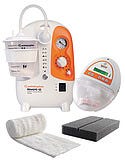Coding Decision Keeps Options Simple For Manufacturers
CMS’s decision to keep the current and single reimbursement code for negative-pressure wound therapy (NPWT) devices is good news for manufacturers, because it maintains a simplified system. In addition, the code benefits doctors and patients, because doctors have the flexibility to choose the most suitable treatment—either gauze or foam—for patients.
January 1, 2010
|
Smith & Nephew’s Renasys EZ system can be used with both the foam and gauze wound interfaces. |
NPWT products treat wounds and skin ulcers. The devices use a pump and vacuum-assisted pressure to draw together wound edges and promote wound healing. Most device components are similar, and the common wound dressings are foam and gauze. According to CMS, there are currently 13 manufacturers of NPWT products.
Suppliers use the Healthcare Common Procedure Coding System (HCPCS) codes (currently there are three NPWT codes) to detail services or items on payment claims that are submitted to payers. If CMS wanted to establish a new HCPCS code, it would need clinical evidence that showed a significant difference, functionally or therapeutically, when compared with devices in the same category code. After assessing available evidence with the help of the Agency for Healthcare Research and Quality and ECRI, as well as holding a public meeting in July, CMS determined that the HCPCS codes were “appropriate and should not be changed,” according to information on the agency’s Web site. The agency’s final decision was released November 3.
“What that means for us [device manufacturers] and patients, is that the HCPCS codes by nature are common language,” says Randall Carson, North American director of government affairs and reimbursement for Smith & Nephew Wound Management (St. Petersburg, FL). “This process provides continued simplification across all payment and payer sources, as well as sites of care. We’ve been operating with specific codes, and the recommendation is that the codes will be the same, so there’s no interruption in terms of learning a new language and process.” The fee schedules remain the same.
For more details about the HCPCS coding process, visit CMS’s Web site at www.cms.hhs.gov/MedHCPCSGeninfo.
About the Author(s)
You May Also Like


.png?width=300&auto=webp&quality=80&disable=upscale)
